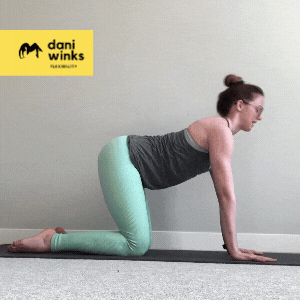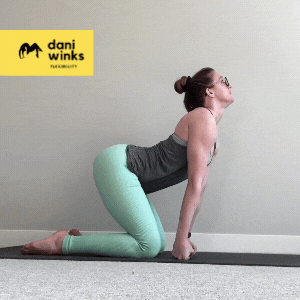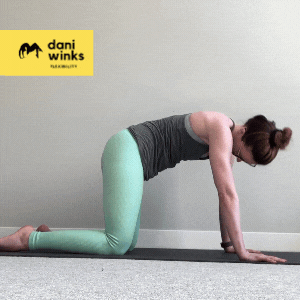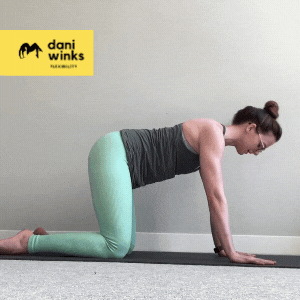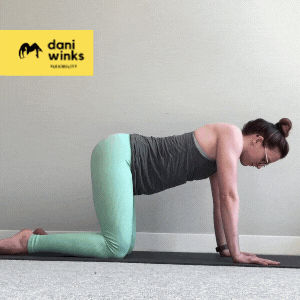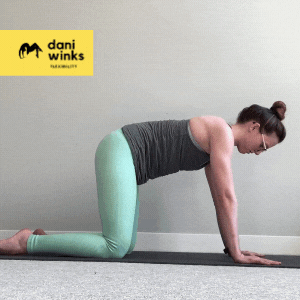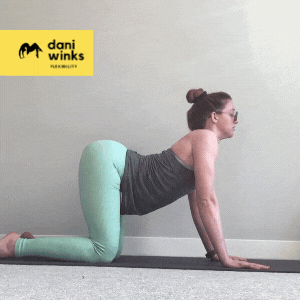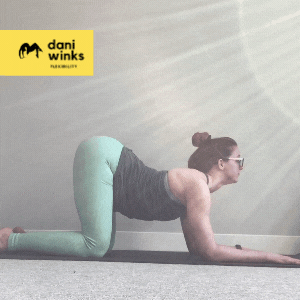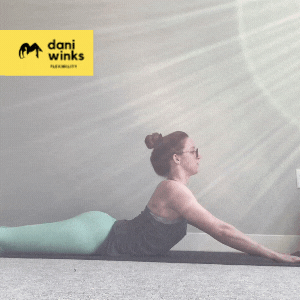6 Cat-Cow Variations for Spinal and Shoulder Mobility
6 Cat-Cow Variations for Spinal and Shoulder Mobility
Cat-cow is hands-down one of my favorite mobilizers to include in my warmup any day I’ll be working on back flexibility. Over the years I’ve learned some funky variations I really like because they help play with spinal mobility and control, and some even get the shoulders more involved:
1. Regular Ol’ Cat Cow
Start on hands and knees with hands under your shoulders and knees under your hips
Round your back by tucking your chin toward your chest, lifting your ribs, and tucking your tailbone (this rounded position is your “cat” pose, rounding your back like a scaredy cat)
Then slowly arch your back by lifting your tailbone, dropping your ribs, and lifting your collarbone and head
Alternate arching and rounding, for 4-8 reps
Variations:
Make it more “active” by engaging your muscles: every time your round your back, consciously push the floor away with your hands and feel your chest muscles engage. Every time you arch your back, try to pull your wrists and forearms back towards your knees, feeling your triceps and lats engage.
2. Narrow Cat Cow
Start on hands and knees (like a regular cat cow), but slide your hands back close to your knees. If this is too intense on your wrists, you can ball your hands into fists instead of trying to keep your palms flat on the floor
Go through your arching & rounding of your cat-cow movement, but with this narrower stance
Repeat for 4-8 reps
3. Disco Cow
Start on hands and knees (like a regular cat cow)
Circle your chest/ribs by dropping it down to the floor, over to one side, up to the ceiling, and over to the other side
Do 4-8 circles in one direction, then switch directions
Variations:
Add in some head/neck circles while you circle your chest
Bend your elbows to make bigger circles with your chest, swooping your chest down toward the mat for a slightly deeper backbend
4. Segmented Cat Cow
This is a fun challenge to work on isolating each part of our back during the movement, breaking it down into our cervical spine (neck), thoracic spine (mid/upper back and ribs), and lumbar spine (low back).
Neck isolation (cervical spine)
Rib isolation (thoracic spine)
Pelvis isolation (lumbar spine)
Start on hands and knees (like a regular cat cow), with a neutral spine
We’ll start by isolating just the neck movement. Keeping your hips, low back, and ribs neutral, start arching your neck by lifting your head. Then drop your chin to round through your neck. Repeat for 3-6 cat cow arches and rounds just through your neck
Then we’ll move on to isolating the movement in our mid/upper back (back of the ribs). Keeping your neck neutral (looking at the floor), and hips neutral, start to round your upper back by pushing your hands into the floor to lift your chest and the back of your ribs up toward the ceiling. Then relax your arms and let your chest droop toward the floor, helping flatten out (or even slightly arch) your upper back. Depending on your flexibility, this may be a small movement! Repeat for 3-6 rib cat cows
Finally we’ll isolate the movement in our low back and pelvis. Keeping your neck and ribs neutral, arch your low back by lifting your tailbone toward the ceiling, then round your low back by tucking your tailbone toward the floor. You may notice your ribs move a little because they’re connected to your low back, but do your best to try to keep the majority of the movement in your pelvis and low back, even if that means making the movement smaller. Repeat for 3-6 pelvis cat cows
Challenge: Try to link all your isolations together to make a wavey cat cow. Starting in an arched cow position, we’ll reverse the arch piece by piece to round our back. Initiate with the head/neck, tucking your chin to your chest to round your neck, then lift your ribs to round your upper back, finally tuck your tailbone to round your lower back. Then - leading from the head - arch your way back to your cow pose: lift your head to arch your neck, drop your ribs to arch your upper back, and lift your tailbone to complete the arch in your low back.
5. Forearm Cat Cow (aka “Kitten Calf”)
From hands and knees, lower down onto your forearms. Your elbows should be right underneath your shoulders, and forearms parallel to the outside edges of your mat
Tuck your chin and tailbone to round through your back, pushing down into your forearms to engage your chest
If you’re finding it difficult to round your back, you can adjust your forearms to bring your hands in to touch so they are no longer parallel to each other, but now making a pizza or a snowplow shape - this will be slightly easier on your shoulders
Then list the crown of your head and tilt your tailbone to the ceiling to arch your back
Repeat for 4-8 reps
6. Low Cobra Cat Cow
I debated adding this one to the list or not because technically it’s more of a “cat-cobra” - but it’s such a nice challenge to use the shoulders in this one I’m going to throw it into the list anyway :)
Start in a low cobra position: lying on the floor on your belly, with your belly and the bottom-most ribs touching the floor, elbows propped underneath your shoulders, trying to lift your collarbone up towards the ceiling
Keeping your chest lifted (don’t let it droop!), reach your hands forwards to straighten your arms - this will be our starting pose (straight arm low cobra)
Tuck your chin towards your chest, and initiate the rounding position by pressing your hands firmly into the floor. Engage your abs by pulling your belly button into your spine. Keep pressing into the floor hard enough to try to lift your hips and tuck your tailbone to round your low back. The end position should look like a very “long” (wide bas, hands far away from knees) cat pose, with your shoulders and back slightly rounded, and abs super engage like in a plank
Hold your nice engaged long kitty for a moment, then slowly lower, starting with your hips, back to your arched straight-arm low cobra position
Repeat for 3-8 cat-cobras
Do you have another favorite variation?
Let me know in the comments below!

